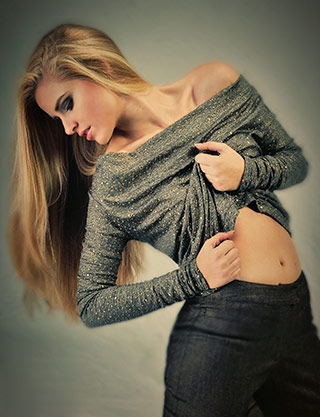
Fashion Photography
Nicole gets comfortable with “Dots – Not Dots,” a handmade Italian jersey fabric top.
OK, I’ll admit it. I’m a camera snob. As a commercial photographer, I’ve always prided myself on having the right equipment for the job. Not the most expensive equipment, mind you, but the right equipment. Especially since the emergence of digital cameras, I’ve learned that it’s easy to catch The Shiny Object Syndrome – the itch to have the latest and greatest super-duper, multi-mega pixelated something-or-other in a race to…mediocrity?
A few years ago, a well-known photographer by the name of Lee Morris wrote an article about not needing a super-fancy camera and expensive equipment to produce commercial-quality images. To make his point, he produced a demonstration fashion series using the iPhone (at the time, he used an iPhone 3).
Lee’s premise was, “There are so many photographers who are obsessed with noise, sharpness, color, dynamic range, megapixels, chromatic aberration, moire’, distortion, etc. So many photographers get wrapped up in the technical side that they forget how to take compelling images.”
And you know what, he’s absolutely correct!
A few things have changed since his ground-breaking work. Smartphone cameras have become far more capable than those available just a few years ago. Indeed, a whole “phoneography” movement has emerged. With a host of add-ons – like interchangeable lenses – smartphone photography has embraced a whole new dimension and put high-quality digital photography within the reach of millions of enthusiasts – without the need to spend thousands of dollars on high-end equipment. The number (and sophistication) of “apps” has grown remarkably. For example, I use an app that does a fairly good job of mimicking the controls (within the limitations of the hardware and firmware of the smartphone) of a high-end medium format camera (such as the Mamiya® 645 or Hasselblad® H System) costing thousands of dollars. Is my app-enabled smartphone as capable as these pro systems? Of course not. The point is that commercial-quality images can – under the right circumstances – be produced by camera systems never intended for pro work.
From Technical to Technique
To produce superlative images regardless of the technical capability of the equipment requires that we look beyond what the equipment can do and focus on what we – as photographers – can do with what we have available. It requires that we refine our technique. For example, smartphones are notoriously prone to camera-shake, even with anti-shake systems enabled (similar to optical- or image-stabilization available with some DLSR’s). An obvious solution to this is – a tripod! Tripods are not appropriate for every circumstance – certainly not for everyday candid work – but can be a valuable assistant for still life or landscape work. Adapting a smartphone to a tripod need not be a complex or expensive affair. Here, I’ve used the DIY-approach: Velcro.
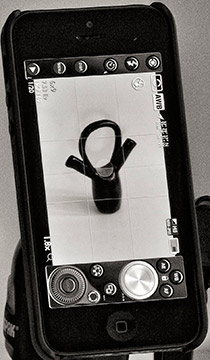
Smartphone camera control
panel offers features found
on high-end camera systems.
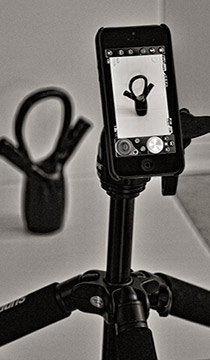
Tripod-mounted smartphone
in a studio setting.
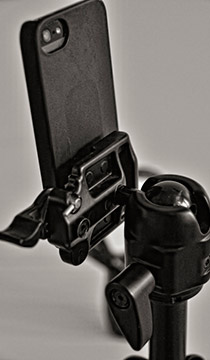
The DIY approach – attach
the smarphone to the
tripod using Velcro.
It’s also important to remember the fundamentals of composition, depth of field, exposure and white balance. This is where the current limitations of smartphone photography begin to bump up against the capabilities of higher-end equipment such as DSLR’s or medium-format cameras. Note, I said “current,” because experience has shown it won’t take long for even further advances in smartphone technology to provide additional flexibility and control over your image creation.
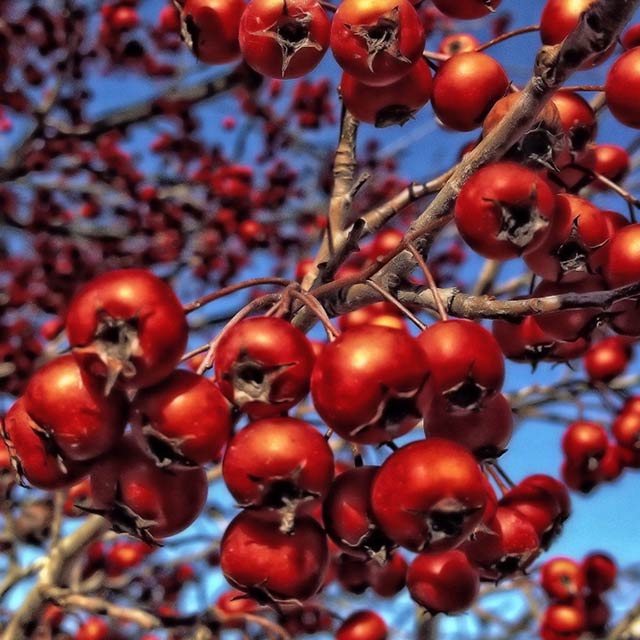
Smartphones can achieve fantastic detail and resolution, but composition and exposure are still fundamental.
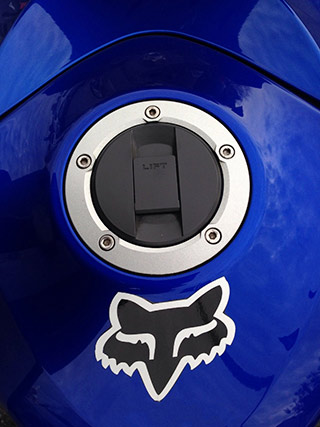
Product Photography? Why Not?
While smartphoneography won’t (yet) meet the exacting technical demands of many print publications, high-resolution photos from the newest generation of smartphones are quite capable of producing detailed product images suitable for online or web publication. Again, the key is paying attention to the fundamentals – exposure, composition, formatting to layout and product enhancement. In product photography, attention to detail is a critical success factor. It wouldn’t matter what kind of camera is used here – the scratch on the motorcycle’s gas tank still has to be touched up.
Detail of motorcycle gas tank captured by a smartphone camera.
Special Effects? Sure!
Sometimes, an ordinary object can be totally transformed by the way an image is presented. Beyond high-resolution image-capture, there is an ever-increasing number of post-processing filters available for smartphones. These can include overall (global) adjustments like color balance filters, film simulators and special effects that can mimic conventional toning, Lomography and even Photoshop®-like actions. Here, an ordinary silk flower illuminated only by standard office fluorescent lighting is transformed into an abstract rendering. The resolution offered by today’s smartphones is sufficient that this image was reproduced as an 18 x 24, eight-color inkjet rendering and is now on display in a gallery.
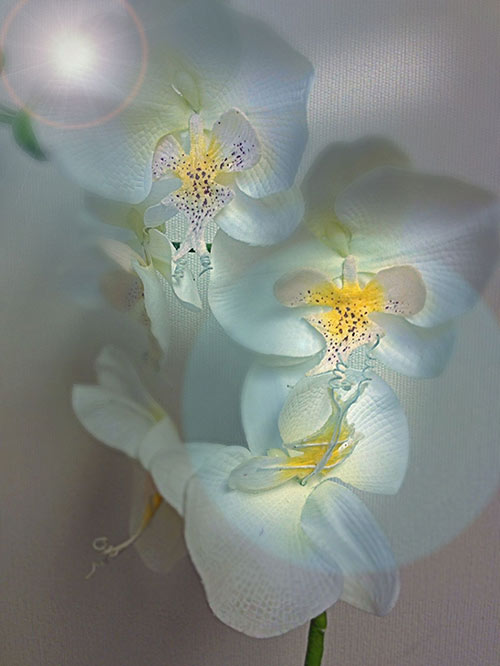
Image of silk flower captured and post-processed by smartphone.
Abstractions of the ordinary can be accomplished in-camera as well. By using the panorama mode in different ways, such as tilting the camera while capturing the image, unusual effects can be created before the image even gets to the post-processing stage.
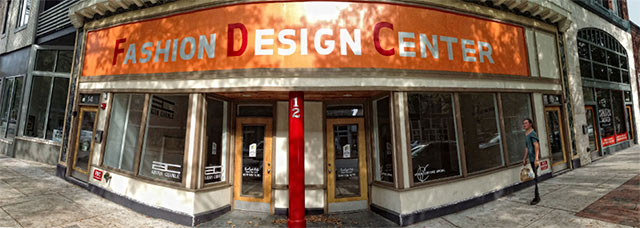
Downtown storefront captured in panorama mode. Note how moving objects (in this case, a passerby) are sometimes abstracted by panning the camera in the direction opposite the movement.

Cornerstone in Washington National Cathedral rendered as abstract image using camera’s panorama mode.
Putting A Stamp on Fashion
Since the experiment mentioned earlier, there have likely been very few commissioned fashion projects produced with a smartphone – certainly not catalogs or “lookbooks.” But the style known as fashion editorial is another thing altogether. With editorial, less emphasis is placed on the technical aspects of garment presentation, and more is placed on creating a mood or telling a story about lifestyle. Here, artistic license is considerably expanded, which lends itself to experimentation with the smartphone. In these examples, our model Nicole demonstrates a range of moods and styles that shows how imagination is the product of human vision, not high-end camera systems.
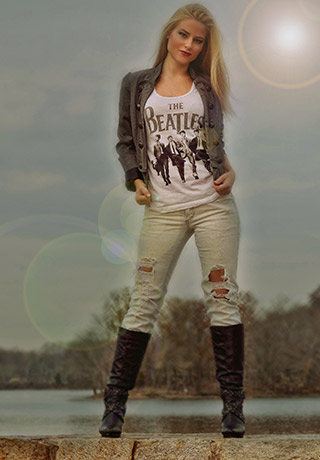
Nicole presents “The Beatles.”
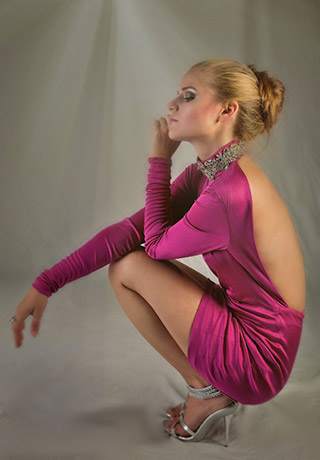
Nicole bathed in light for Chanlé Encore, a luxury couture line of specialty gowns and dresses.
Workflow is Workflow
Regardless of the medium used to capture an image, successful commercial photography depends on pre-planning, technical execution, appropriate use of technique, post-processing, and most importantly – imagination! Whether you use film, a DSLR, medium-format, or smartphone, these fundamentals are the foundation for successful image creation.
In our next installment of Confessions of a Camera Snob, we’re going to crank it up a notch and show how a high-end fashion editorial series can be accomplished with only an inexpensive ($29.00) plastic toy camera. Until then, check your camera for your messages!
by Allen Moore
Credits: All text and photos: © 2014 Allen Moore. All rights reserved.
One exception: Nicole presents “The Beatles,” courtesy of one of my students – © 2014 Samantha Gibson. All rights reserved.
Model: Nicole Car

Leave a Reply